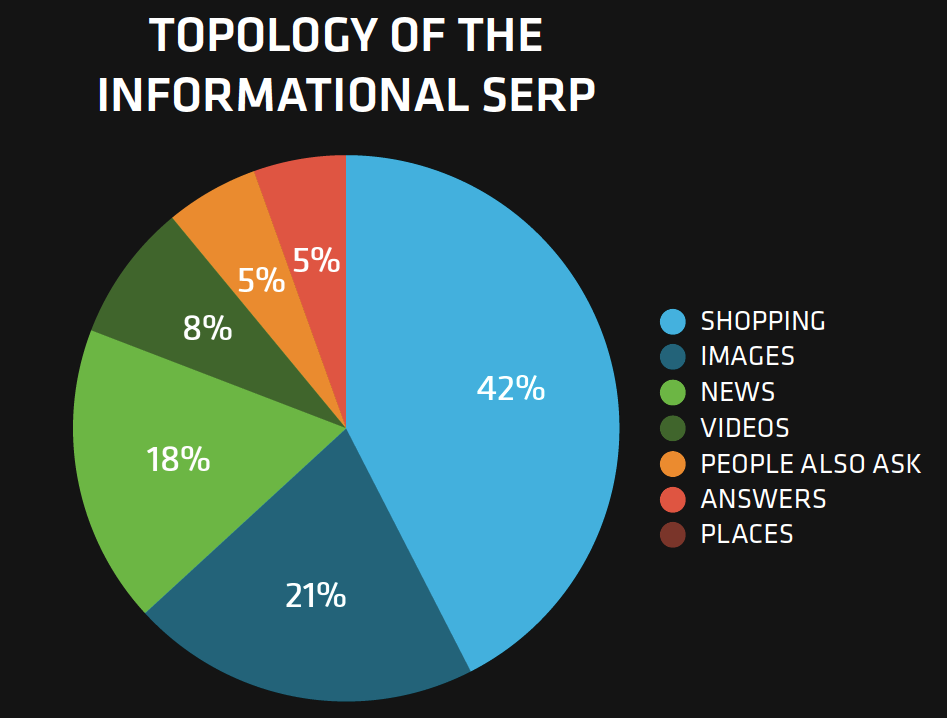
MozCon 2017: Reverse-Engineer Google’s Research to Serve Up the Best, Most Relevant Content for Your Audience
The following post is part of WTWH Media Marketing Lab’s ongoing blog series from MozCon 2017. You can find the full presentation here.
As any search marketer knows, the SERP is the front-lines of Google’s multi-billion dollar consumer research machine. So naturally, they’re well-aware of what searchers want. In his data-heavy talk at MozCon 2017, Rob Bucci of STAT Search Analytics discussed how to uncover what Google already knows about the things web searchers are looking for and how to better leverage this information to deliver the right content to the right searchers at the right time.
The Perpetual Evolution of Google
Instant gratification is the key to Google’s success. Google gives us the answers we need and it gives us them faster than we could ever imagine. In their ability to do this, they’ve changed the fundamentals of how the world works. As a result, they’ve also changed human behavior. We as a species have become accustomed to the instant retrieval of information, and because of this shift in expectation, Google has actually become a victim of their own success. How? In creating this platform for gratification, Google has had to quickly adapt to rapidly changing consumer habits. Essentially, once they change the rules, they are then forced to play by these new rules; as Bucci put it, “it’s like a giant drawing a map while its footsteps alter the landscape.”
So, if Google is evolving perpetually, how are marketers supposed to keep up? By properly researching and analyzing the search engine results page, or SERP, we can essentially snoop on Google’s research and learn what our customers are looking for when they search for something. Before we can do that; however, we need to understand one of the cornerstones of search marketing: intent.
Consumer Search Intent
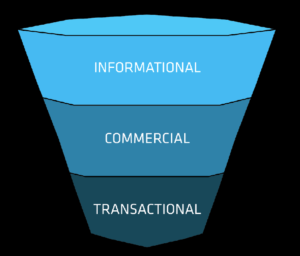
Source: STAT Search Analytics
Searcher intent is the new demographics. Why? Demographics don’t help us understand what consumers are looking for in an exact moment – or where they are looking to find it. Search intent, however; can tell us everything we need to know in almost real time.
Bucci suggested that there are three key stages of consumer intent when making queries on a search engine: informational, commercial, and transactional. As you would expect, consumers have varied intent depending on which stage of the purchase funnel they are at.
Informational
The informational stage is the start of the path to purchase. In this stage, consumers are doing research on products or services that they are interested in learning more about. For example, if someone is interested in learning more about metal bearings, their search queries in the informational stage would typically contain terms like “bearings” or “metal bearings” and questions like “what is a metal bearing” or “what are the differences between types of bearings?”. It’s important to understand that if you’re trying to engage with people in this stage of the funnel, you should seek to answer questions and provide information, not make an immediate sale.
Commercial
Perhaps the best definition of the commercial stage comes from Moz Wizard Rand Fishkin:
[It] is not directly transactional, and may never result in an exchange of goods, services, or monies, but [it’s] not purely informational either.
But what exactly does that mean? In the informational stage, consumers are conducting high level, general research to get a better understanding of the concept in question. In the commercial stage, consumers are refining their queries to inch them closer to a potential purchase. So, someone in the commercial stage from the metal bearings example from above would be searching for things like “high-performance bearings”, “metal bearing reviews”, or “best metal bearings for industrial applications”. While they may not be quite ready to buy, they’re clearly interested in the product or service beyond their initial research. Since consumers are using superlatives like “best” and opinion focused words like “reviews”, SEO can do a lot of heavy lifting during this stage.
Transactional
The third stage Bucci described is what’s known as the transactional stage. In this stage, consumers are “buy ready” and are looking for the best method to do so, querying terms and phrases like “buy metal bearings” or “cost of metal bearings”. Through their research done in the informational phase, the consumer has exhibited interest in metal bearings. With the specific information found in the commercial stage, they’ve also started to narrow their search down to the exact brand or model that they want. All that’s left to is to actually make the purchase and complete the transaction.
As Rob pointed out,” intent beats identity and immediacy beats loyalty”. In the age of digital gratification, consumers no longer care about the image of your company or the affinity they have for certain brands; if you can answer their question and solve their problems at the exact moment they enter something into the search box, you will win the day.
Lessons Learned
Google’s core organic algorithm does an amazing job of determining which results are most useful to a given searcher’s intent. Through his extensive research, Bucci was able to reverse-engineer the SERP at each of three stages of the funnel mentioned above. Here’s what he learned:
Informational
- The prevalence of shopping boxes can’t be ignored; a paid strategy is required to give searchers what they want here
- Look for strong bias towards certain sites; you’re not going to displace a site like Wikipedia when it comes to the featured snippets
- Looking at the SERP topology tells us what Google thinks these searchers want; in this stage, Bucci saw searcher needs being met by news, images, and organic. This is what Google has determined is the best outcome for these searches
- News results are often crowded with irrelevant stories; don’t just blindly chase search volume. Look deeper to understand if there’s a real opportunity.
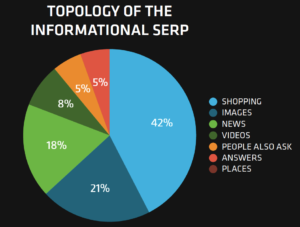
Source: STAT Search Analytics
Commercial
- By using share of voice, measure which domains are winning; for example, TechRadar still beats Amazon with 3,000 fewer rankings.
- Perform share of voice analysis on result types to assess their potential; what’s allowing a site like TechRadar to beat out Amazon? The answer, as Bucci found through share of voice analysis, was their featured snippets
- Segment even deeper on query modifiers like “best” to see how the SERP adapts; for “best” searchers want snippets. For compare, they want videos. This is where you get some of the most actionable insight into searcher intent
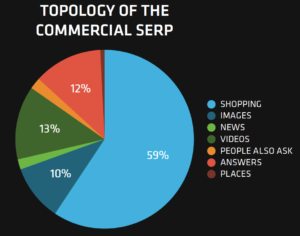
Source: STAT Search Analytics
Transactional
- The deeper down the funnel you go, the more you have to rely on organic rankings; catering content towards universal results isn’t going to win the day when searchers are this low in the funnel
- Analyze ranking URLs to find out what UX satisfies the searcher’s intent; in Bucci’s research, the majority of pages that ranked the highest were category pages
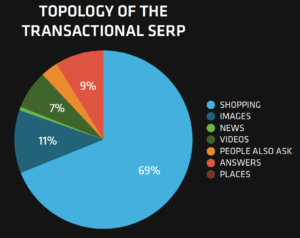
Source: STAT Search Analytics
Be There. Be Useful. Be Quick.
After all was said and done, Bucci came up with one prevailing adage; be there, be useful, and be quick.
To be there, it’s crucial to conduct quality keyword research and thoroughly segment your strategy by intent stage. You will know if you’re “there” by measuring your share of voice and breaking it out by each stage or result type.
To be useful, you need to look at the topology of the SERP and find out what Google determines is helpful to searchers. Once you’ve figured this out for your own use case, it’s important to create strategic content experiences that satisfy searcher’s immediate needs.
To be quick, start optimizing your site’s speed and make sure it gets right to the point, omitting everything that distracts the searcher from fulfilling their immediate need. People want their information fast, and they don’t have time to wait for a 2MB image to load.
Key Takeaways
Bucci and his team learned a lot from their research. One of the most important takeaways was that optimizing for universal results is the best way to ensure you’re satisfying the wide range of searcher intent. To better understand intent, marketers need to thoroughly research the topology of the SERP and analyze what Google is determining to be the most useful results. If Google knows how to satisfy intent, you can learn too. With this knowledge of intent, we can begin to craft the right content for the right moment of the searcher’s journey and be well on our way to dominating the SERP.
For more information regarding search intent and reverse engineering the SERP, download STAT Search Analytics’ white paper, Using Search Intent To Connect With Consumers.
 Rob Bucci is the founder and CEO of STAT Search Analytics. He’s been a developer and entrepreneur in SEO space since 2005, and he especially loves tackling big-data challenges in data mining and analytics.
Rob Bucci is the founder and CEO of STAT Search Analytics. He’s been a developer and entrepreneur in SEO space since 2005, and he especially loves tackling big-data challenges in data mining and analytics.



Leave a Comment
You must be logged in to post a comment.